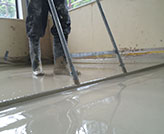It may seem a rather obvious comment, but when it comes to constructing the flooring in a building you naturally want it to be as flat and level as humanly possible. That is, unless it is in a wet room when you need the floor to be sloping. Even so, you want the floor surface to be smooth and even.
This is why it is necessary to use a screed on top of the concrete in order to have a smooth surface upon which to lay the final flooring, whatever that may be. In fact, if you are laying tile, for example, it is essential. If you lay tile on a surface that is not even, then as people walk on the final floor covering, some of the tiles are going to begin to crack. Not a good idea!
For many years, builders and contractors have used a cement screed in Manchester in order to achieve the best outcome. This is a mix of an aggregate – usually sand – with a ratio of one part of cement to 3 – 5 parts of the aggregate. It produces a thin substance similar to concrete that can be laid on the substrate and levelled out by hand using a trowel.

Time-Consuming
Naturally, levelling out a cement screed in Manchester by hand is time-consuming, not to mention tiring for the operative. However, it will produce a reasonably level surface, but unlikely to achieve what is known as SR1.
SR stands for Surface Regularity and is a measure of the “waviness”, if any, of the surface. Using a 2-metre straightedge laid on the floor, the measurement is taken using a slip gauge to check the depth of any gaps that appear. SR1 allows a maximum of 3mm. SR2 allows for 5mm, while SR3 is 10mm. A sand and cement screed may achieve SR2, but not all that often.
This is why more and more contractors are turning to the liquid screeds that we provide at UK Screeds. A liquid screed, also known as flowing screed, is self-levelling. Think about it. It is in liquid form, and liquids settle down level. It will almost always achieve SR1.
There are other advantages too. It is far quicker to lay than sand and cement, typically covering up to 2,000 square metres in a day. It also dries very quickly. It can be walked on in 24 – 48 hours, so it does not delay other contractors who need to work on the site.







